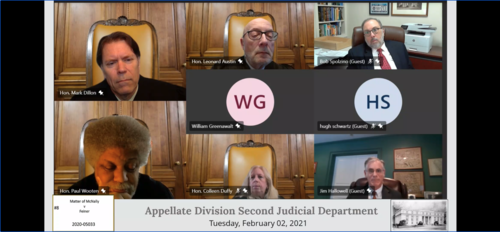Petition lawsuit: Town Supervisor's appeal of Supreme Court ordered election now available online.
EIC Petition Court Case
Thursday, the New York Appellate Division, Second Judicial Department in Brooklyn heard oral argument on matter of Edgemont’s incorporation petition. To watch a replay, click here and go to the 43 min 20 sec mark of the video.
Notably, when argument ended, the justices remarked to each other about the large turnout for our case. One said: “They got the whole town here.” We are proud that so many Edgemont residents were present.
The EIC would also like to thank Edgemont resident Jim Hallowell and his legal team at Gibson, Dunn & Crutcher LLP and Bob Bernstein from Bernstein & Associates PLLC for logging countless hours and so expertly representing our community. We sincerely appreciate it.
Decisions for the Appellate Division, Second Department are usually handed down 4-6 weeks after oral argument. Of course, that is not a guarantee, but it is a reasonable expectation.
School is ending and summer fun beckons, but please stay tuned on incorporation. The EIC will continue to conduct research, track legislation, and keep the community posted.
Modern Municipal Thinking
The following piece appeared in today’s Scarsdale Inquirer:
Most municipalities in the New York area still operate with staffing models that reflect organizational thinking and technology capability from a generation ago. While some local governments have innovated and progressed, others carry heavy legacy costs for staffing and old systems dragging on their budgets.
The traditional staffing model, followed well into the 1980s by both corporations and municipalities alike, called for at least one employee per function with new hires commensurate with the demands of the function. Municipalities also generally ran their own information technology internally and supplied all services themselves. But times have long since changed.
Many public companies seeking to improve shareholder returns, or in some cases survive at all, have been forced to become more efficient, cutting staffing, adopting technology and outsourcing some services or manufacturing. Large companies with dedicated resources often underestimate small innovators because they believe the upstarts can’t succeed without scale. Similarly, defenders of “old economy” municipalities may criticize newer models of government for having fewer people to perform individual functions or not “owning” all its services. But having more workers does not mean guarantee more productivity; it just guarantees more workers.
Forward-looking municipalities with fresh leadership have embraced the governance concepts of performance measurement, competition, shared and outsourced services, multi-faceted employees, and privatization where appropriate. They’ve also adopted cost-saving technology for tasks (such as online records storage and property tax billing and collection) that formerly required a manual process and dedicated employees.
For example, in Rye Brook, the village manager is also the clerk, while in Hastings the village manager is also the treasurer. Rye Brook bids out its sanitation contract every three years; its per-household hauling costs are substantially below Greenburgh’s while delivering a higher service level.
Our Greenville Fire District also employs a “multiple hats” program. Its 30 firefighters “double-duty” as fully trained EMTs (or higher). Why? Because the GFD doesn’t need more employees to meet our community’s first-responder EMS demands, so instead it utilizes an incentive program for its existing staff. Similarly, the GFD Chief himself is also a firefighter, while the district’s one administrative employee handles finance, filings, and FOILs for an entity with a $9 million budget. We simply don’t need (and no one is calling for) a separate CFO, clerk, and district manager.
Multiple roles, competition, and outsourcing — including sharing services with other communities—keep costs down. The resulting budgetary savings may be returned to the community in the form of lower taxes, investment in quality-of-life improvements, or both.
Edgemont has a unique opportunity to create a smart, modern, efficient village that embraces shared-service principles, works in close partnership with its neighboring municipalities, and delivers excellent services.
-The EIC






